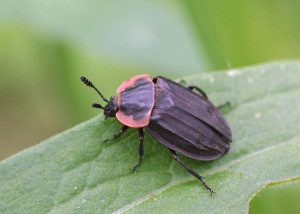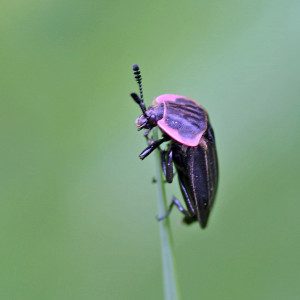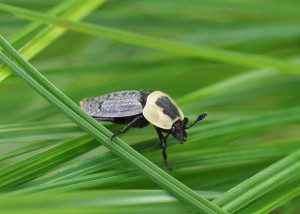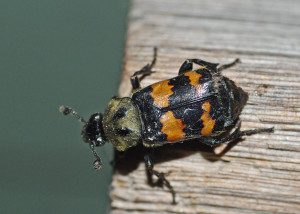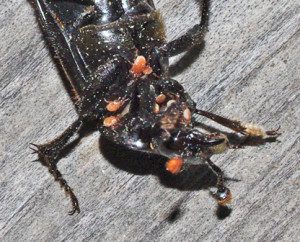Salutations, BugFans,
Carrion and Burying beetles (family Silphidae) have graced these pages before – the BugLady wrote about two different genera seven years ago (Seven! Years!). You can find that story at https://www4.uwm.edu/fieldstation/naturalhistory/bugoftheweek/carrion-beetles.cfm, and pictures of those beetles are included here. The first episode came with an NftFoH (Not for the Faint of Heart) warning; this one isn’t (quite) as grisly.
A word about its names. The MARGINED CARRION BEETLE (Oiceoptoma noveboracense) is so-called because of the salmon-colored borders on its black thorax. Silphidae is a small family, with only about 200 species worldwide (46 in North America); and the genus Oiceoptoma totals seven species – three north of the Rio Grande. Several blogs say that its species name, “noveboracense,” (“from/pertaining to New York”) means that the beetle originated in the state of New York. In fact, it means that the “type specimen” – the one upon which the description of the new species was based (in this case, in 1771 by Johann Reinhold Forster (incidentally, a man with a really bad temper)) – was collected in New York.
Several blogs also parrot each other in calling this sturdy, diurnal (active during the day) scavenger a “lightning beetle mimic,” because of its wide, colored thoracic shield and the somewhat protruding tip of its abdomen, but none of the more scientific sites speculated on that. Since lightning beetles ooze toxic blood when provoked, mimicking one would be a handy knack.
Margined carrion beetles are found throughout eastern North America into the Great Plains except, says bugguide.net, in the Deep South. They live in grasslands and, rarely, marshes, but research has shown that they have a preference for deciduous forests. Although a few Silphid family members may be found in trees, the Margined carrion beetle stays close to the ground.
They are a bit smaller than some of their cousins, measuring a half-inch-ish. Adults are flattened, which helps them maneuver under the corpses they do business with. The brown larvae (http://bugguide.net/node/view/287753/bgimage) look like they just crawled out of a patch of Upper Devonian shale.
What do they eat? The name only tells part of the story. But first, a peek into how big Margined carrion beetles make little Margined carrion beetles. The male stays on top of her elytra (hardened outer wings) for some time both before and after mating, at first holding on to her antennae with his mouthparts, and later, alternately stroking her pronotum (that big thoracic shield) and antennae with his antennae, which may stimulate her to lay eggs.
Ms. Margined carrion beetle lays her eggs in rotting meat or in the dirt around it (she locates a corpse by using chemoreceptors on her antennae and mouthparts to sense the by-products of decay). She prefers larger corpses so there will be something left for her offspring after the flies are done. She does not, as her orange and black Nicrophorus cousins do, bury the corpse, nor does she, as Nicrophorus does, carry around hitchhikers in the form of small mites, which dive in and eat the fly maggots that are competing with her young. These the Margined carrion beetle eats herself (a form of pest control).
The larvae hatch surrounded by food (carrion) but they also feed on rotting fungi, and they may move around some during this stage. Adults eat carrion and fly maggots and are found at sap drips on wounded trees (as both adults and larvae, “Halitosis R US!”). In the “Exception that proves the rule” category, the larvae of a Silphid named Nicrophorus pustulatus (awesome name) appears to be parasitoids of snake eggs.
Larvae eat, pupate, and emerge as adults in the space of about 45 days, and they overwinter as adults. There is one generation per year, and researchers notice two peaks in the population – one in spring and one after the new adults appear in late summer. An interesting study of Silphids found in woodlands in southern Ontario found that the several species present do not breed/lay eggs at the same time, a scheme called “resource partitioning.”
Margined carrion beetles are fairly early arrivals at a corpse; consequently, their rhythms have been well-charted by forensic entomologists, and everyone has seen enough CSI shows to know what that means. Mostly, though, carrion beetles officiate at the small, quiet deaths of the forest, and by their actions return to the system nutrients that are vital to life there.
Kate Redmond, The BugLady
Bug of the Week archives:
http://www4.uwm.edu/

